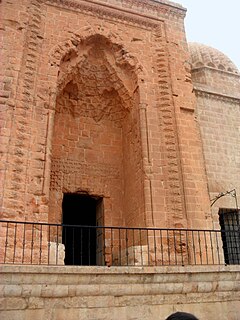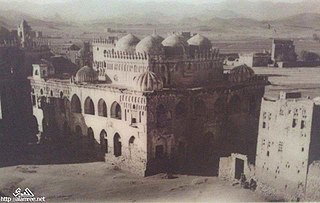
The Wazir Khan Mosque is 17th century mosque located in the city of Lahore, capital of the Pakistani province of Punjab. The mosque was commissioned during the reign of the Mughal Emperor Shah Jahan as part of an ensemble of buildings that also included the nearby Shahi Hammam baths. Construction of Wazir Khan Mosque began in 1634 C.E., and was completed in 1641.

The Kuwait Towers are a group of three slender towers in Kuwait City, standing on a promontory into the Persian Gulf. They were the sixth, and last, group in the larger Kuwait Water Towers system of 34 towers, and were built in a style considerably different from the other five groups. The Kuwait Towers were officially inaugurated in March 1979 and are regarded as a landmark and symbol of modern Kuwait. The towers were closed for maintenance from March 2012 to 8 March 2016, with a massive fireworks festival commemorating the re-opening.

Baltit Fort is a fort in the Hunza valley, near the town of Karimabad, in the Gilgit-Baltistan region of northern Pakistan. Founded in the 8th CE, it has been on the UNESCO World Heritage Tentative list since 2004.

Al-Azhar Park is a public park located in Cairo, Egypt.
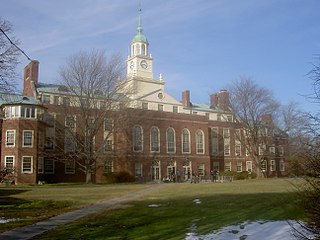
Oleg Grabar was a French-born art historian and archeologist, who spent most of his career in the United States, as a leading figure in the field of Islamic art and architecture.
The Aga Khan Trust for Culture (AKTC) is an agency of the Aga Khan Development Network (AKDN), a family of institutions created by Aga Khan IV with distinct but complementary mandates to improve the welfare and prospects of people in the developing world, particularly in Asia and Africa. It focuses on the revitalization of communities in the Muslim world—physical, social, cultural, and economic. The AKTC was founded in 1988 and is registered in Geneva, Switzerland, as a private non-denominational philanthropic foundation.
The Historic Cities Programme (HCP) of the Aga Khan Trust for Culture (AKTC)] promotes the conservation and re-use of buildings and public spaces in historic cities of the Muslim World. HCP undertakes the restoration and rehabilitation of historic structures and public spaces in ways that can spur social, economic and cultural development. Individual projects go beyond technical restoration to address the questions of the social and environmental context, adaptive reuse, institutional sustainability and training. In several countries, local Aga Khan Cultural Service companies have been formed to implement projects under the supervision of the HCSP headquarters in Geneva.

Mustansiriya Madrasah was a medieval era scholarly complex that provided a universal system of higher education. It was established in 1227 C.E and was named after and built by the Abbasid Caliph al-Mustansir in Baghdad, Iraq. The Madrasa taught many different subjects, including medicine, math, literature, grammar, philosophy and Islamic religious studies. However, the major focus of education was in Islamic law. It became the most prominent and high-ranking center for Islamic studies in all of Baghdad. Madrasas during the Abbasid period were used as the predominant instrument to foster the spread of Sunni thought as well as a way to extend the founder's pious ideals. The architecture of the Madrasa was also an important example of Islamic architectural development in Baghdad. The Madrasa has experienced several periods of decline and reemergence throughout its history. The most significant degradation to the Madrasa's architecture and position within Baghdad, was the Mongol Siege of Baghdad (1258). Today, the Madrasa is in a state of restoration as is it being overseen by the Directorate of Antiquities in Iraq. It is currently a part of the Al-Mustansiriya University, and is located on the left bank of the Tigris River, the building survived the Mongol sack of 1258, and has been restored. Nearby buildings included the Saray souq, the Baghdadi Museum, Mutanabbi Street, the Abbasid Palace and Caliph's Street.

Thula or Thila is a town in west-central Yemen. It is located in the 'Amran Governorate.

Selma Al-Radi was an Iraqi archaeologist who began and led the over twenty-year restoration of the Amiriya Madrasa, which is under consideration as a UNESCO World Heritage Site.
Michael Meinecke was a German art historian, archaeologist and Islamic studies scholar who was director of the Museum of Islamic Art in Berlin from 1988 to 1995.
The following is a timeline of the history of the city of Sana'a, Yemen.

Bab al-Yaman, lit. "Gate of the Yemen," is the main gate of Sana's old fortified wall, on the southern extremity of the walled city, its current design built in the 17th century by the Turks. Today, it is the most ornate of the gates of Sana's Old City. Passengers travelling southward, en route to Ma'bar and Dhamar, would depart from this gate.
Tourism in Yemen refers to tourism to Yemen. Traditionally, Yemen has been a tourism centre for centuries as it is at the middle of the trade routes of the Middle East and the Horn of Africa. Tourism played a fundamental role of the region in global trade and has remained so until the 20th century. Afterwards, there has been a sharp decline in tourism since the 2011 Yemen Crisis. The rise of extremism caused fear in prospective foreign tourists to Yemen. Yemen has four World Heritage Sites, some of the sites have been attacked including historic old city of Sana'a. In 2015 UNESCO declared its plan to protect the world heritage sites of Yemen.

The Shahi Hammam, also known as the Wazir Khan Hammam, is a Persian-style bath which was built in Lahore, Pakistan, in 1635 C.E. during the reign of Emperor Shah Jahan. It was built by chief physician to the Mughal Court, Ilam-ud-din Ansari, who was widely known as Wazir Khan. The baths were built to serve as a waqf, or endowment, for the maintenance of the Wazir Khan Mosque.
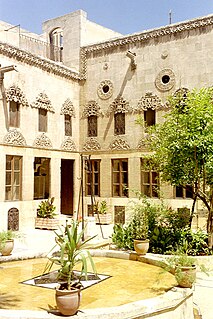
Beit Achiqbash is an old Aleppine courtyard mansion built in the mid 18th Century by Qarah Ali (Karaly), a wealthy Christian merchant.
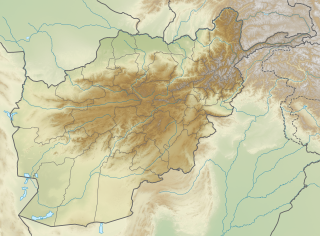
The Shrine of Khwaja Abd Allah, commonly called the Shrine at Gazur Gah and the Abdullah Ansari Shrine Complex, is the funerary compound of the Sufi saint Khwaja Abdullah Ansari. It is located at the village of Gazur Gah, three kilometers northeast of Herat, Afghanistan. The Historic Cities Programme of the Aga Khan Trust for Culture has initiated repairs on the complex since 2005.

